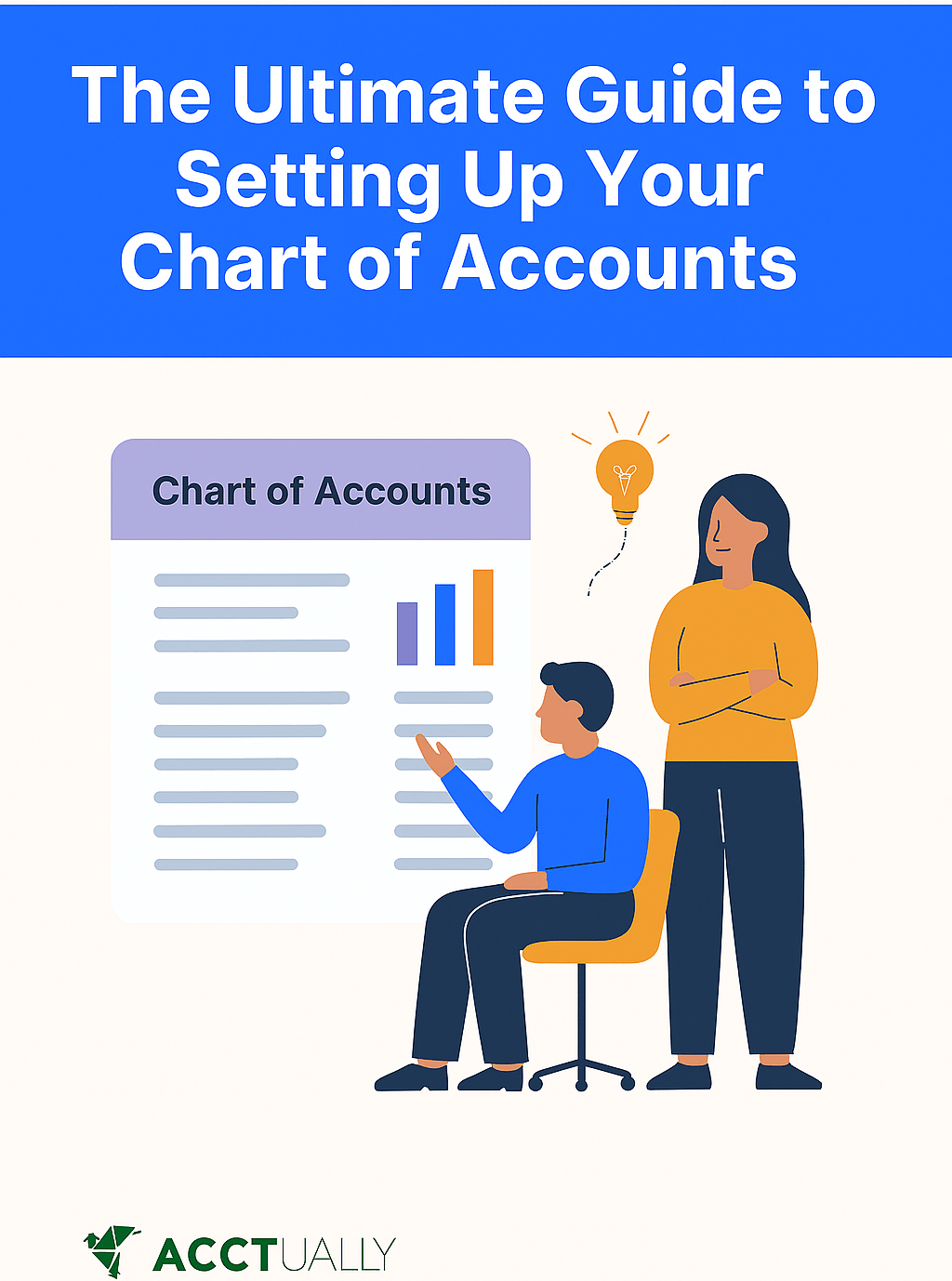The Ultimate Guide to Setting Up Your Chart of Accounts the Right Way
Learn how to set up your Chart of Accounts the right way with this comprehensive guide for small businesses. Understand account types, numbering, structure, and best practices to simplify bookkeeping and improve financial reporting.


The Ultimate Guide to Setting Up Your Chart of Accounts the Right Way
When it comes to small-business accounting, your Chart of Accounts (COA) is one of the most important tools you have — but often one of the most misunderstood. Think of your COA as the master blueprint of your financial system. It tells your accounting software exactly where to record every transaction, how to categorize income and expenses, and how your reports are built.
Get it right, and your financials become clear, accurate, and easy to manage.
Get it wrong, and everything becomes messy — inaccurate reporting, confusing categories, and a much harder time making decisions or preparing taxes.
Whether you’re setting up your COA for the first time or cleaning up what you already have, this guide breaks down everything you need to know.
What Is a Chart of Accounts?
Your Chart of Accounts is simply a structured list of all the accounts your business uses to track money. It organizes transactions into categories so your Profit & Loss and Balance Sheet make sense.
Most small businesses use five major account types:
Assets – What your business owns
Liabilities – What your business owes
Equity – The owner’s interest in the business
Revenue – Money earned
Expenses – Money spent
Each account gets a name and a number, making it easier to sort and report on your financial activity.
Why Your Chart of Accounts Matters
A well-designed COA:
Improves accuracy in your books
Makes tax preparation easier
Supports better decision-making
Helps identify overspending or inefficiencies
Keeps your business compliant
Allows clean, consistent reporting month after month
If your bookkeeping feels messy or your reports don’t make sense, the COA is usually one of the biggest culprits.
How to Structure Your Chart of Accounts Properly
1. Use a Numbering System That Makes Sense
Most COAs follow a numbering pattern like this:
1000–1999: Assets
2000–2999: Liabilities
3000–3999: Equity
4000–4999: Revenue
5000–6999: Expenses
This structure ensures your accounts stay organized and grouped logically.
For example:
1010 – Checking Account
1050 – Accounts Receivable
2000 – Credit Card
4100 – Product Sales
5100 – Software Subscriptions
Numbers don’t matter as much as consistency — but consistent numbering makes everything easier.
2. Keep It Simple (Don’t Overcomplicate)
A common mistake? Creating too many accounts.
You don’t need separate accounts for “Office Supplies – Pens,” “Office Supplies – Paper,” and “Office Supplies – Coffee.”
Keep your categories broad enough to stay clean but detailed enough to be useful.
Use:
“Supplies”
“Software Subscriptions”
“Marketing & Advertising”
“Contract Labor”
Simple COA = simple bookkeeping.
3. Tailor Your Accounts to Your Industry
While every business needs basic categories, you should also customize for your industry.
For example:
A consulting firm might need:
4100 – Service Income
5000 – Contractor Costs
A retail business might need:
1200 – Inventory
5100 – Cost of Goods Sold
A SaaS company might add:
4200 – Subscription Revenue
5300 – Hosting Costs
Your COA should reflect how your business actually operates.
4. Separate Owner Activity From Business Activity
One of the fastest ways to create messy books is mixing personal and business activity.
Your COA should clearly separate:
Owner’s Draw
Owner Contributions
Payroll (if applicable)
This keeps the Balance Sheet accurate and prevents tax issues later.
5. Create Expense Categories That Support Decision-Making
Instead of random categories, think strategically:
Which expenses do you want to track?
Which ones help you understand profitability?
Where do you want clarity?
For example:
“Marketing & Advertising” helps track ROI
“Software Subscriptions” helps you identify unused tools
“Wages” vs. “Contract Labor” helps analyze staffing costs
Good categories = good insights.
Red Flags Your Chart of Accounts Needs a Cleanup
If any of these sound familiar, your COA needs a refresh:
❌ You have multiple accounts that mean the same thing
❌ You don’t know where to categorize certain expenses
❌ Your Profit & Loss report is 3+ pages long
❌ Your Balance Sheet never seems accurate
❌ You can’t easily identify your major revenue streams
❌ Your accountant keeps asking questions about your categories
Most businesses don’t realize how much clarity a clean COA can create until they fix it.
How Often Should You Review Your Chart of Accounts?
At least once a year — ideally before tax season or the new fiscal year.
But if your business is growing or changing quickly, review it more often.
Good times to update your COA include:
Launching new revenue streams
Scaling your team
Switching software
Preparing for investors or lenders
A COA isn’t “set it and forget it” — it should evolve as your business evolves.
How a Clean COA Helps You Make Better Decisions
A well-organized Chart of Accounts gives you:
📌 Clearer reporting
📌 Better budgeting
📌 More accurate margins
📌 Easier cash flow management
📌 Faster tax preparation
📌 Cleaner books year-round
It becomes the foundation of all financial clarity — and financial clarity leads to better decisions.
Don’t Know Where to Start? Chart of Accounts a Mess? Give Us a Call.
If setting up or cleaning up your Chart of Accounts feels overwhelming, you’re not alone — most business owners never get taught this, yet it’s critical for smooth bookkeeping.
At Acctually, we help small businesses build clean, accurate financial systems that make reporting simple and decision-making easier.
📞 Not sure where to start? Books are a mess? Give us a call.
Let’s make your financial foundation clean, clear, and built for growth.
👉 Contact us today to get your finances working for you, not against you.
📧 Email us at hello@acctually.com
🌐 Visit us at https://acctually.com/
📞 Call us at (646) 543-4916
